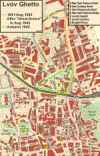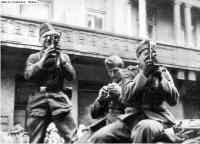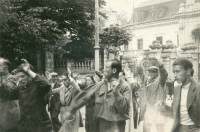L'viv (Lwow / Lvov) was the third largest Jewish community in pre-war Poland. Prior to
nearly 110,000 Jews lived in the town. Germany invaded Poland on
. On
the Soviets invaded Poland too. The Soviet invasion was a result
of the Hitler - Stalin Pact. Lviv capitulated to the Soviet army and remained under
Soviet occupation until
. During this time the number of Jewish residents
in Lwow increased to 160,000. Around 100,000 Jews living in German occupied Poland
fled to Lviv and its environs.
Under the Soviet occupation, Jews officially had equal status with other nationalities.
Some collaborated with the Soviet authorities, others were persecuted. In
hundreds of Lviv Jews and refugees were deported to Siberia when they refused to
take up Soviet citizenship. Jewish political activists were arrested.
. The Ukrainian population celebrated the German occupation, by installing
.
Immediately after this occupation Polish and Ukrainian anti-Semites (of whom the Ukrainians formed the
majority) organized a
.
Ukrainian nationalists
informed the population of the town that these mass executions were retribution for the mass
(People's Commissariat of Internal Affairs) during the last days of Soviet occupation.
The Ukrainians accused the Jews of helping the NKVD with the
arrest and execution of "Ukrainian patriots".
In truth, the majority of those killed were Polish nationalists and intellectuals, although there were
also Ukrainians and Jews among the victims. During the four week pogrom nearly 4,000 Jews
were killed in Lviv.
.
Groups of Polish professors from Lviv universities were also killed.
Lviv’s Jews had to wear a badge with a blue Star of David. In the same
month the
was established. Its first
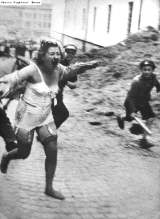 |
| Riots in July 1941 * |
chairman was the lawyer
Josef
Parnes. He was executed by the
Gestapo in
November 1941 for his
refusal to turn over Jews for forced labour. His successor was
Henryk Landsberg.
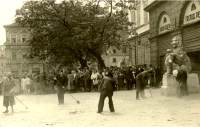 |
| Humiliated Jews at the Town Hall |
On
25 July 1941 Ukrainian nationalists organized the next pogrom in Lviv - the so
called "Petlura Days" (named after
Semen Petlura, hetman of
Ukraine at the end of WW1, who organized anti-Jewish pogroms in this country. After WW1 he
was killed by a Jew in France). During the "Petlura Days" nearly 2,000 Jews were killed
in Lviv. On
2 October 1941 the first 500 Jewish men were recruited as forced labour for
the German Armament Works (
Deutsche Ausrüstungswerke - DAW Lemberg) in Lviv. They were
employed constructing a work camp on
Janowska Street.
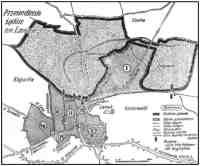 |
| 1941 Resettlement Map |
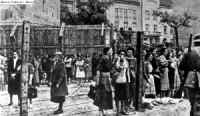 |
| Jewish Women behind the Fence * |
On
8 November 1941, the German civilian administration issued the
order to establish a ghetto in Lviv. All Jews were forced to move into the ghetto
before
15 December 1941. The German police organized selections on
Peltewna Street
during this time. Nearly 5,000 elderly and sick Jews were selected and shot. This "action"
was called "Action under the bridge". At this time there were between 110,000 and 120,000 Jews
in the ghetto.
The first deportation of Jews from the Lviv Ghetto to the
Belzec death camp was
organized
between 16 March and 1 April 1942. Prior to deportation the forced
labourers were registered in the ghetto. Around 15,000 Lviv Jews were deported at this time to
Belzec. Most were elderly and religious people, and women with children.
They were assembled in the
courtyard of the Sobieski School and after selection they
were taken to
Kleparow railway station,
near the
Janowska camp,
from where the deportation trains departed for
Belzec. Officially this
action was called "action against antisocial elements". Together with the deportations from the
Lublin ghetto, which were carried out at the same time, this transport
from the Lviv Ghetto was the first one during
Aktion Reinhard.
After this deportation around 86,000 Jews officially remained in the ghetto. There were also
a large number of "illegal" Jews in the ghetto. Workshops were set up. Large numbers of Jews worked for the
Wehrmacht,
Luftwaffe and the German civil administration outside the ghetto.
On
24/25 June 1942 the "Great Round-Up" (
Großrazzia) was carried out
in the ghetto by the
Germans. Around 2,000 Jews were taken to the
Janowska camp. Only 120 of them
were selected for forced labour. Others were executed on the
"Sands" (Piaski)
near the camp.
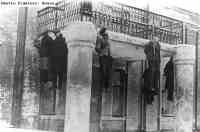 |
| Hanged Jews in Lviv * |
Between 10 and 31 August 1942 the "Great Action" was carried out. Prior to
this action hundreds of forced labourers were taken to
Janowska and to the
small work camp on
Czwartakow Street in the SS and Police district of Lviv.
During the "Great Action" between 40,000 and 50,000 Jews were deported to
Belzec.
The assembly points for the deportations were on
Teodor Square, at
Sobieski School and on
the square in front of the
Janowska camp. Nearly 1,600 men were selected for
forced labour and they were concentrated at the camp on
Janowska Street.
Other people were deported daily from
Kleparow railway station to
Belzec. About 1,000 people were shot in the ghetto, among
them the children from the orphanage and patients from the Jewish hospitals. The round-ups
in the ghetto were organized by the SS, Ukrainian and Jewish police. On
1 September
1942, following the last deportations, the
Gestapo publicly hanged
Henryk Landsberg, chairman of Lviv’s
Judenrat, and
Jewish policemen. They were no longer needed after the "Great Action".
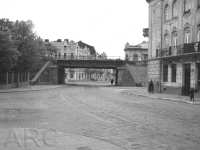 |
Former Ghetto Entrance
at Zamarstynowska Street |
 |
| Jewish Quarter |
At the
beginning of September 1942 there were still around 65,000 Jews in the ghetto,
among them around 15,000 "illegals". Some Jews hid in the sewers of Lviv and with help
from local Poles survived until liberation. The heavily guarded ghetto was surrounded by barbed wire.
The living conditions were extremely primitive with lack of water
and medical aid and overcrowded accommodation. In
late autumn 1942 a typhus epidemic spread
throughout the ghetto. At the
beginning of November all Jews were "barracked", according to
profession. Only people with work cards could stay officially in the ghetto.
On
18 November 1942 the SS carried out a selection. Around 5,000 "unproductive"
Jews were arrested and deported to
Belzec. The Jewish hospital was liquidated
and its head, Dr
Kurzrock, was sent to the
Janowska camp.
Between 5 and 7 January 1943 the next "action" was carried out. 15,000-20,000 Jews,
including
the last members of the
Judenrat, were taken to the
"Sands" where they
were executed. The Germans proclaimed, that only Jews with a work permit could remain within
the ghetto which was then reclassified as a forced labour camp. The
Judenrat was dissolved.
During this "action" the SS set houses on fire with the purpose of flushing Jews out of hiding.
Many Jews were burnt to death.
 |
| Assembled for Forced Labour * |
The work camp within the former ghetto only existed until
1 June 1943. There were
still "illegal" Jews remaining after the selections. During the final liquidation
of the labour camp within the ghetto the Jews organized an armed resistance, killed
and wounded several policemen. In addition to the SS, German and Ukrainian police units
of the
Hitlerjugend participated in the liquidation of the ghetto. The SS and police blew
up the ghetto buildings and set them on fire when they met resistance. They did the same
to bunkers where large numbers of Jews hid. Around 7,000 Jews were taken to
Janowska
camp and after selection most were shot on the
"Sands". Probably some of the
group were deported to
Sobibor. 3,000 Jews were killed in the ghetto during its
liquidation.
The last of Lviv’s Jews were gathered at
Janowska, where they were executed on
18 November 1943, during the
Aktion Erntefest. When on
26 July 1944 the Soviet Army entered Lviv, only
200-300 Jews had survived in hiding in the town and its environs.
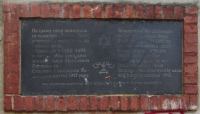 |
| Memorial Plaque |
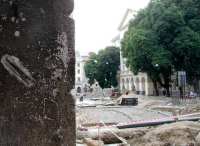 |
| Mezuzah Doorway with Townhall |
One of Lviv’s most famous residents was
Simon Wiesenthal who,
with his wife
Cyla, was
moved from the ghetto to
Janowska. Towards the
middle of 1942,
Wiesenthal
and his wife were assigned to forced labour at the eastern railway repair shops.
Simon
Wiesenthal's mother, aged 63, was deported in
August 1942 to
Belzec,
and his wife's mother was shortly thereafter shot by a Ukrainian police auxiliary on the
steps of her house in the ghetto.
Simon Wiesenthal survived the
horror of
Janowska and imprisonment in
Groß-Rosen,
Buchenwald, and
Mauthausen. After liberation
Simon Wiesenthal dedicated his life to bringing to justice Nazis guilty of war
crimes. He played a leading part in the arrest and trial of
Franz Paul Stangl,
commandant of
Treblinka, as well as bringing to justice other
Aktion Reinhard leaders like
Hermann Höfle
and
Ernst Lerch, responsible for the killing of 1.8 Million Jews in the death
camps in East Poland.
Odilo Globocnik, head of all extermination camps in Poland,
was arrested by Allied troops in Austria in
May 1945 where he committed suicide.
Wiesenthal was also involved in the arrest and capture of
Adolf Eichmann.
More
Lviv comparison photos.
Photos:
GFH
*
Sergei Nikolsky
*
Sources:
Encyclopedia of the Holocaust
Tatiana Berenstein: Eksterminacja ludnosci zydowskiej w dystrykcie Galicja (1941-1943). "Bulletin
of the Jewish Historical Insitute in Warsaw", 1967.
Wlodzimierz Bonusiak: Malopolska Wschodnia pod rzadami Trzeciej Rzeszy (Eastern Malopolska
Under the Rule of the Third Reich). Rzeszow 1990.
David Kahane: Lvov Ghetto Diary. Amherst 1990.
Aleksander Kruglov: Deportacja ludnosci zydowskiej z Dystryktu Galicja do obozu zaglady w Belzcu.
(The Deportation of the Jewish Population from Galicia District to the Death Camp in Belzec):
"Bulletin of the Jewish Historical Institute in Warsaw", No. 3 (1989).
Thomas Sandkühler: "Endlösung" in Galizien. Der Judenmord in Ostpolen und die
Rettungsinitiative von Berthold Beitz 1941-1944. Bonn 1996.
www. ushmm.org
Simon Wiesenthal - Justice not Vengeance. London 1989
© ARC 2005







